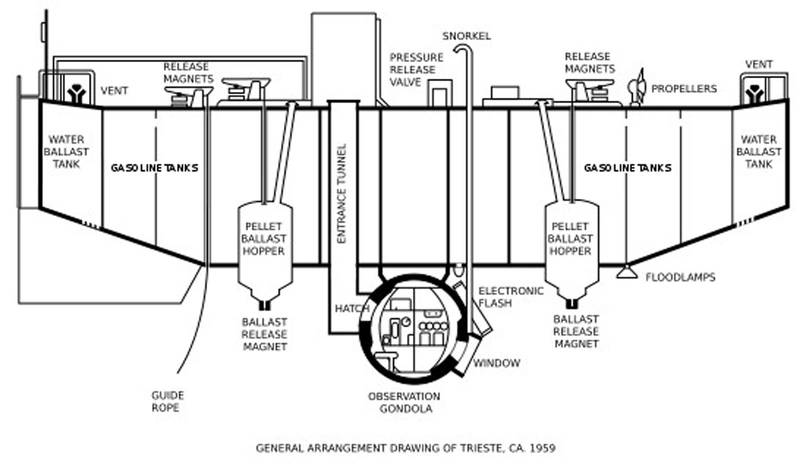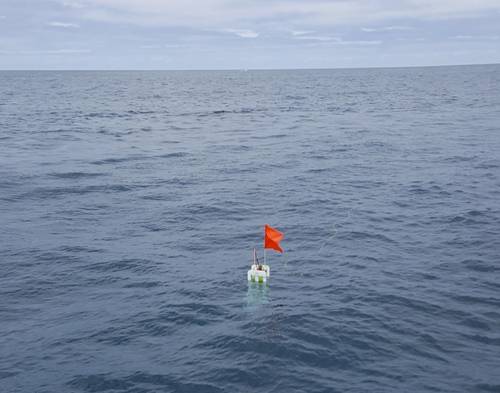Reader Feedback: Lander Lab - Buoyancy
Thanks to the' Landereans' who replied to the article “BUOYANCY!”, in the May/June 2022 issue of MTR (Vol. 65, No. 4). There have been some very interesting follow-on conversations:
LIQUID SYNTACTIC
Kevin Ulmer, nU-Boats LLC:
“Enjoyed your article on buoyancy in the latest Marine Technology News. Your idea of glass micro balloons suspended in liquid exists as "pumpable buoyancy" from the Aubin Group. https://www.aubingroup.com/products/renewables/pumpable-buoyancy/
“I’m developing what I call “enhanced” liquid syntactics with different depth ratings, densities, simplified formulation and ability to cross-link in place. Aubin developed their “pumpable buoyancy” for a very specific application in the offshore oil & gas industry but there are many other applications for such material as you might well imagine.
“Keep up the great work!”
From Kevin Hardy:
I really like the idea of pumping positive buoyancy rather than negative buoyancy for trim. You probably recall the 1960's approach of pumping mercury ballast around. Yikes! Argo floats use the idea of variable displacement by pumping oil across a bulkhead to create buoyancy. The idea is that the displaced volume changes while the net mass remains the same, thereby changing density to some value greater or less than 1. It would take a smaller volume and less energy if the material were a "liquid syntactic” with a lower specific gravity, as you coin the term.
As one suggestion for your application, I use mineral oil (baby oil) for a number of p-comp applications. It has a specific gravity of 0.845-0.905, and is about as benign an oil as you can find.
From Kevin Ulmer:
“Yes, I think the version of Alvin I dove in back in the early 70’s used mercury as did Cousteau’s diving saucer.
“I’m very familiar with buoyancy engines and will be using those in my nU-Ray glider.
“3M offers a range of "glass bubbles" as they like to call them with different pressure ratings. One of the components you could vary in the liquid syntactic formulation.”
COMPRESSED AIR BUOYANCY SYSTEMS
From Capt. Charles MacVean (USN, retired):
Kevin, I read with interest your article on Buoyancy. I noticed that you spent a vast majority of the article on rigid or non-compressible buoyancy materials and systems, and little on compressible flotation systems. I know you have experience with both compressed gas compensation and flotation systems, and have amassed a body of work on these non-rigid systems. Perhaps you could use that scientific evidence and field experience to substantiate the attractiveness of compressed gas as a shallow water alternative to rigid flotation systems.
Your next article could be greatly enhanced if you included some pictures of the “soft systems”. Such an article would be a real hoot.
Keep up the good work,
Charlie
From Kevin Hardy:
Thanks for the comments, Charlie. Yes, I focused more on deep water than shallow, and skipped over the use of compressed gas systems for buoyancy. Ultimately, Boyle’s Law (P1V1 = P2V2) determines the useful depth of a compressed gas system for buoyancy. That said, the shelf break of the continental shelf is nominally 100-200m, where pressures are just 10-20 bar. The compressed systems developed for that zone could be shown in a dedicated column “BUOYANCY, Part 2. I read an interesting paper on a buoyancy engine that exploits the volume and pressure changes accompanying the reversible electrochemical interconversion of water to hydrogen and oxygen gases, providing soft VB displacement for subsea vehicles. That description also suggests it can supply breathing oxygen for a manned system as well. We’d have to look closely at the energy requirements of said system. Gaseous CO2 liquifies at a pressure of just 5.2 bar (74psi) between a temperature range of -56°C (-69°F) and 31°C (87°F), so that could be used near-surface from a pressurized liquid CO2 source. Also see RC Shipyard <https://www.rcshipyard.com/tech/#7> for some creative approaches to model submarine ballast and trim systems using small compressed air pumps and flasks. A USN training film (1955) discusses the placement and operation of ballast tanks in a diesel-electric submarine. Two fins up! (https://www.youtube.com/watch?v=OvI4bFAiwZY).
EQUIVALENT SPECIFIC GRAVITY
In a conversation with Phil Zerofski, Marine Technician at Scripps Institution, the question of an apples-to-apples comparison between the densities of hollow glass flotation spheres and syntactic foam came up, what we might call “equivalent specific gravity.”
Let’s make a comparison between a 13” Vitrovex glass sphere rated for 7000m and the HZ-34 syntactic from eSyntactics, also rated for 7000m. Fresh water, used for calculating density, is 62 lbs/ft^3. The HZ-34 weighs in at 34 lbs/ft^3 in air. The equivalent specific gravity of the syntactic is 34/62 = 0.548. The 13” glass sphere has a volume of 0.670 ft^3 and weighs 19-lbs in air, yielding a density of 28.35 lbs/ft^3. The equivalent specific gravity of the glass sphere is 28.35/62 = 0.457. Thus, for equal depth ratings, the glass sphere has a lower equivalent specific gravity, and therefore generates more lift for an equal volume. That’s only one point of comparison, but an interesting one.
SPALLING OF GLASS SPHERES
From Steffen Pausch, Managing Director, Nautilus Marine Service, Buxtehude, Germany
While we’re on glass spheres: I reported in the BUOYANCY article, “Random surface spalling may be due to residual stresses of the casting and forming operation.”
Steffen writes, “We have recently done 250 cycles on two 13” spheres to 630bar with superfast ramp up rate (altogether more than 1 week in the pressure chamber). To our own surprise, not a single piece of glass came off, just nothing.” NMS plans to release the test results confirming the continuous improvement of the production method and the integrity of the glass spheres at a later date.
BATHYSCAPHE TRIESTE BUOYANCY
Interview with John Michel, Chief-of-the-Boat, Bathyscaphe TRIESTE Image: U.S. Navy“The ‘scaphe used Aviation gasoline for buoyancy. Av gas is very nice. The density is the same every time. The Av gas is 7.2% compressible at 16,000 psi. I still remember the number. We got the Av gas from a tank on the bay side of Point Loma, but when we got back, we had to get towed over to North Island to pump it out. There was something like 32,000-gallons. That’s a lot of frickin’ gasoline! (He said with a chuckle.) If it was a cold day, the Av gas would have shrunk, and was heavier. We would take her out to dive, and she’d sink fast. If it was a hot day, the Av gas would expand, and Trieste would float pretty high.
Image: U.S. Navy“The ‘scaphe used Aviation gasoline for buoyancy. Av gas is very nice. The density is the same every time. The Av gas is 7.2% compressible at 16,000 psi. I still remember the number. We got the Av gas from a tank on the bay side of Point Loma, but when we got back, we had to get towed over to North Island to pump it out. There was something like 32,000-gallons. That’s a lot of frickin’ gasoline! (He said with a chuckle.) If it was a cold day, the Av gas would have shrunk, and was heavier. We would take her out to dive, and she’d sink fast. If it was a hot day, the Av gas would expand, and Trieste would float pretty high.
“In Tank 6 we had a small cylindrical tank of Av gas that we used for buoyancy adjustment. This is the only one we can dump. If we were too light, we could vent some of that gas. But we had it set up so that if the electric valve got stuck open, we wouldn’t lose all the gas in Tank 6. The valve was fail-safe closed, so if we lost power, that valve would stay closed.
“If we got too heavy we could drop iron shot. We could’ve dropped the whole shot hopper if we had to. The bottom of the hopper is shaped like a funnel. An electromagnet encircled the bottom of the funnel, stopping the iron shot from falling out. It was fail-safe off, so if we lost power, the electromagnet would shut off, all the shot would drop, and the ‘scaphe would come up. The iron shot was a special alloy with low magnetic permeability, which means the iron shot won’t become temporarily magnetized and not drop out when needed. We started with shot from Trieste, Italy, but found a U.S. company, Cleveland Abrasives Company, whose shot was better in every way.
“Once full of Av gas, we’d hang the ‘scaphe under a big crane and see how she is sitting in the water. We’d throw 25-lb bags of iron shot on the top deck to trim her out. Then we’d add that shot to the fore or aft hopper, depending on which was closer.
“A tank at each end of Trieste was full of air to keep her afloat. Both tanks had an inverted J-pipe with a wood cork that plugged the hole. There was a cage to keep the wood plug centered on the J-pipe. When the ‘scaphe was ready to dive, Giuseppe would use a wood mallet to knock one plug loose, then run to the other end of Trieste and knock the other plug loose. They flooded pretty fast. After she submerged, the wood corks would float up and plug the holes so the tanks would hold air after she came back up.
“Back at NEL, after all the Av gas was pumped out, we would take the ‘scaphe back to our quay, where we would lift it up with that big crane onto its cradle.
“There was still around 300 gallons left in the buoyancy tanks. I made the valves that fit on the low point of each tank.
They had a garden hose fitting on the bottom, so we didn’t have to mess around looking for a special hose. We’d open each of these and drain what was left in the tanks into a wheeled 300-gallon tank.
“Then we’d use a large compressor to blow air into the bottom of the tanks and out the top to evaporate the remainder of the gas. It took about 2 days for all the gas to evaporate. That was really the only dangerous part of putting the ‘scaphe back in stand-by mode. The air coming out of the compressor was hot. The base commander once came by when we had just started the procedure. I told the base commander, if Trieste didn’t blow-up in the first 30 minutes, we knew we’d be OK. He stuck around for the full 30 minutes.” (Interview with Kevin Hardy, June 27, 2022)















 December 2025
December 2025



